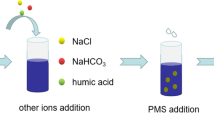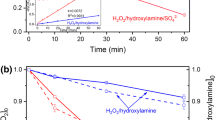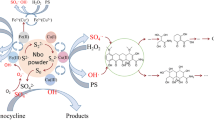Abstract
The persistence of recalcitrant pollutants in water is a major health issue calling for advanced and green techniques to clean polluted waters. For instance, direct activation of peroxydisulfate by visible light without any catalyst displays a remarkable potential to degrade recalcitrant pollutants in water, and the involved reactive species in pure conditions with deionized water have been elucidated recently. However, the impact of phosphates, which are commonly abundant in real waters, on the performance of this reaction is still unclear, and possible formation of secondary phosphate radicals has yet to be clarified. Here we studied the effect of phosphate on the degradation of atrazine by peroxydisulfate under visible light. Radicals were studied by electron paramagnetic resonance. Results show that 10 mM of phosphate as H2PO4−/HPO42− decreased the pseudo-first-order rate constant of atrazine degradation by 47.6% in the peroxydisulfate/visible light system at pH 7.0. The degradation kinetics of atrazine correlated linearly with the concentration of phosphate and was pH dependent. Optimal degradation efficiency was achieved at pH 7.0, while higher pH significantly impeded atrazine degradation. These results suggest that the inhibitory effect of phosphate is due to the formation of less reactive phosphate radicals. This hypothesis is supported by the effect of pH on atrazine degradation and the reduced peak intensities of reactive species in electron paramagnetic resonance. Our findings imply that the presence of phosphates could highly decrease the efficiency of pollutant removal in real situations.



Similar content being viewed by others
Explore related subjects
Discover the latest articles and news from researchers in related subjects, suggested using machine learning.References
Ahn YY, Yun ET, Seo JW et al (2016) Activation of peroxymonosulfate by surface-loaded noble metal nanoparticles for oxidative degradation of organic compounds. Environ Sci Technol 50:10187–10197. https://doi.org/10.1021/acs.est.6b02841
Armstrong DA, Huie RE, Koppenol WH et al (2015) Standard electrode potentials involving radicals in aqueous solution: inorganic radicals (IUPAC technical report). Pure Appl Chem 87:1139–1150. https://doi.org/10.1515/pac-2014-0502
Che M, Chen Z, Qiu S et al (2021) High chloroform removal using tannic acid to promote the activation of persulfate with Fe/Ni nanoparticles. Environ Chem Lett 19:4015–4020. https://doi.org/10.1007/s10311-021-01293-w
Chen L, Huang X, Tang M et al (2018) Rapid dephosphorylation of glyphosate by Cu-catalyzed sulfite oxidation involving sulfate and hydroxyl radicals. Environ Chem Lett 16:1507–1511. https://doi.org/10.1007/s10311-018-0767-y
Ji Y, Yang Y, Wang L et al (2019) Sulfate radical-induced incorporation of NO2 group into chlorophenols. Environ Chem Lett 17:1111–1116. https://doi.org/10.1007/s10311-018-00836-y
Lee J, Von Gunten U, Kim JH (2020) Persulfate-based advanced oxidation: critical assessment of opportunities and roadblocks. Environ Sci Technol 54:3064–3081. https://doi.org/10.1021/acs.est.9b07082
Liu H, Bruton TA, Doyle FM, Sedlak DL (2014) In situ chemical oxidation of contaminated groundwater by persulfate: decomposition by Fe(III)- and Mn(IV)-containing oxides and aquifer materials. Environ Sci Technol 48:10330–10336. https://doi.org/10.1021/es502056d
Luo C, Ma J, Jiang J et al (2015) Simulation and comparative study on the oxidation kinetics of atrazine by UV/H2O2, UV/HSO5− and UV/S2O82−. Water Res 80:99–108. https://doi.org/10.1016/j.watres.2015.05.019
Maruthamuthu P, Neta P (1977) Reactions of phosphate radicals with organic compounds. J Phys Chem 81:1622–1625. https://doi.org/10.1021/j100532a004
Maruthamuthu P, Neta P (1978) Phosphate radicals. Spectra, acid-base equilibria, and reactions with inorganic compounds. J Phys Chem 82:710–713. https://doi.org/10.1021/j100495a019
Morin-Crini N, Lichtfouse E, Fourmentin M et al (2022) Removal of emerging contaminants from wastewater using advanced treatments. Rev Environ Chem Lett 20:1–43. https://doi.org/10.1007/s10311-021-01379-5
Neta P, Madhavan V, Zemel H, Fessenden RW (1977) Rate constants and mechanism of reaction of SO4—with aromatic compounds. J Am Chem Soc 99:163–164. https://doi.org/10.1021/ja00443a030
Neta P, Huie RE, Ross AB (1988) Rate constants for reactions of inorganic radicals in aqueous solution. J Phys Chem Ref Data 17:1027–1284. https://doi.org/10.1063/1.555808
Prashantha Kumar TKM, Mandlimath TR, Sangeetha P et al (2018) Nanoscale materials as sorbents for nitrate and phosphate removal from water. Environ Chem Lett 16:389–400. https://doi.org/10.1007/s10311-017-0682-7
Velusamy K, Periyasamy S, Kumar PS et al (2021) Advanced techniques to remove phosphates and nitrates from waters: a review. Environ Chem Lett 19:3165–3180. https://doi.org/10.1007/s10311-021-01239-2
Wen Y, Huang C-H, Ashley DC et al (2022a) Visible light-induced catalyst-free activation of peroxydisulfate: pollutant-dependent production of reactive species. Environ Sci Technol 56:2626–2636. https://doi.org/10.1021/acs.est.1c06696
Wen Y, Sharma KV, Ma X (2022b) Activation of peroxymonosulfate by phosphate and carbonate for the abatement of atrazine: roles of radical and nonradical species. ACS ES&T Water 2:635–643. https://doi.org/10.1021/acsestwater.1c00482
Yang Y, Banerjee G, Brudvig GW et al (2018) Oxidation of organic compounds in water by unactivated peroxymonosulfate. Environ Sci Technol 52:5911–5919. https://doi.org/10.1021/acs.est.8b00735
Zhou Z, Liu X, Sun K et al (2019) Persulfate-based advanced oxidation processes (AOPs) for organic-contaminated soil remediation: a review. Chem Eng J 372:836–851. https://doi.org/10.1016/j.cej.2019.04.213
Funding
This study is financially supported by the Development of Water Programs of Excellence by Texas Water Resources Institute.
Author information
Authors and Affiliations
Corresponding authors
Ethics declarations
Conflict of interest
The authors declare no competing financial interests.
Additional information
Publisher's Note
Springer Nature remains neutral with regard to jurisdictional claims in published maps and institutional affiliations.
Supplementary Information
Below is the link to the electronic supplementary material.
Rights and permissions
Springer Nature or its licensor holds exclusive rights to this article under a publishing agreement with the author(s) or other rightsholder(s); author self-archiving of the accepted manuscript version of this article is solely governed by the terms of such publishing agreement and applicable law.
About this article
Cite this article
Wen, Y., Lichtfouse, E., Sharma, V.K. et al. Overlooked involvement of phosphate radicals in the degradation of the atrazine herbicide by sulfate radical-based advanced oxidation. Environ Chem Lett 21, 15–20 (2023). https://doi.org/10.1007/s10311-022-01523-9
Received:
Accepted:
Published:
Issue Date:
DOI: https://doi.org/10.1007/s10311-022-01523-9




